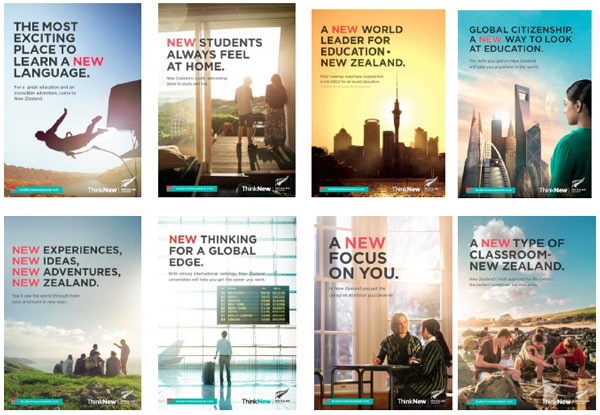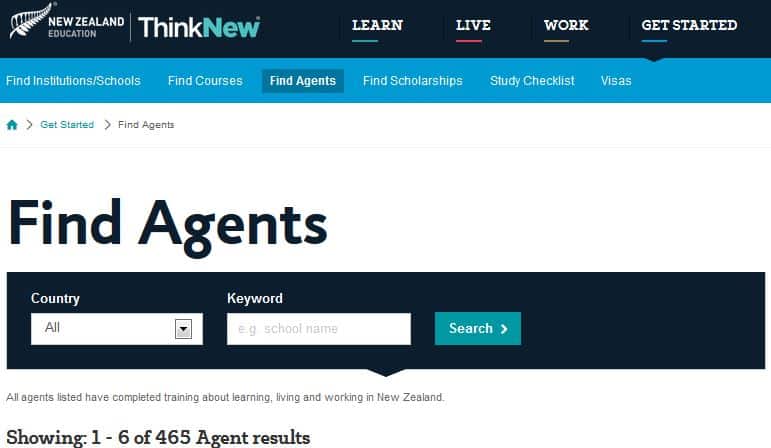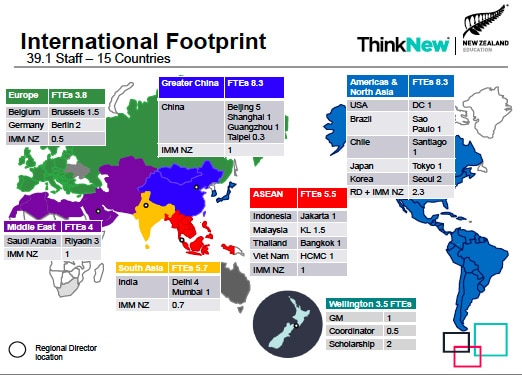New Zealand rolls out marketing campaign and new visa services
New Zealand is taking its goal to double the value of its international education sector by 2025 (to NZ$5 billion) very seriously. In 2013, the government invested an additional NZ$40 million in funding over four years to promote the country as an international study destination, with the guidance that special attention be paid to key markets such as China, India, Southeast Asia, and South America. The money has helped to create a new marketing campaign – Think New – that is currently rolling out in key markets. In addition, in line with growing evidence showing how important a country’s visa, work, and immigration policies are to its ability to attract – and retain – international students, New Zealand is also introducing new visa processes to make it easier and faster for students to get the documentation they need to study in the country. The two-pronged approach – (1) smart, targeted marketing that as we will see, involves and leverages institutional and agency partners, plus (2) the facilitation of visa logistics – stands to provide an amazing case study illuminating best practices in international student recruitment. We’ll start with recent international enrolment trends in New Zealand, then move on to the Think New campaign and the country’s new online visa services.
New Zealand’s international student population may once again be on the rise
Overall, 2012/13 was not a standout year for New Zealand in its goal to build its international enrolment. The number of international students approved to study in New Zealand (64,232 students) fell 7% from 2011/12 – matching a 7% decrease in 2010/11. The government points to factors such as “the high New Zealand exchange rate, increased international competition for export education and the February 2011 Christchurch earthquake” as contributors to the recent dips in enrolment. The Chinese international student population (the largest single foreign source for New Zealand, as in many leading destination countries) remained more or less stable, but the proportion of students from South Korea decreased by 21% and from India by 7%. This is all amid a longer-term context of declining or flat international student enrolments since 2003. Here’s the good news: in the second half of 2013, from July to December to be exact, the number of international student visa approvals issued by New Zealand (32,632) jumped by 10% compared to the same period in 2012. And, the increase was even more dramatic among new international students: 14%. New Zealand's main markets bounced back - contributing to this increase were China (31% of New Zealand’s international students in the July-December 2013 time frame), India (16%), and South Korea (7%).
Think New prioritises key markets, and zeroes in on targeted prospective student profiles
As with any good marketing campaign, New Zealand’s Think New begins with a problem. Kathryn McCarrison, General Manager Marketing and Channel Development for the Think New brand, explains:
“Our research shows that New Zealand is close to halfway behind the awareness levels of key competitor countries: we’re just not top of mind when students overseas are considering their options.”
This is despite some of the world’s most breathtaking scenery, a safe and open-minded environment, and an education system noted for:
- Devoting the highest proportion of public expenditure to education of 32 countries (OECD 2012 survey);
- Being the best of 142 countries for education (London-based think tank The Legatum Institute’s 2012 Prosperity Index survey);
- Having all its universities featured in the 2013/14 QS World Top 500 University Rankings, and ranking in the top 50 in 18 subjects including accounting and finance, engineering (civil and structural), education, law, and psychology.
The Think New campaign aims to highlight facts like these, and includes stunning photography and video.

- As much as its goal is to raise awareness of New Zealand as a study abroad choice and provide information on the types of education available in the country, Think New also has a goal of capturing students’ contact details and information for deeper, more personalised marketing down the line.
- The creative focuses on storytelling and evokes an emotional response.
- It is being executed in different countries at different times for concentrated focus on results in particular countries. In addition, different areas of the New Zealand education system are being emphasised depending on the priority country. For example, the focus is universities in China, tertiary education in India, and English-language schools in Japan. But all agencies that have been briefed on the campaign and asked to help leverage it are well informed about all aspects of New Zealand education so they can handle queries about other student interests as they come up.
- Industry groups helped to decide the list of priority countries.
- Think New acknowledges the value of agents, and actively seeks them out as partners. Says Ms McCarrison: “[The campaigns are] the first trial of a partnership approach with key education agencies … [who] will amplify the campaign messages through their own networks.” In fact, a central campaign goal is to introduce students in key markets to specific agencies who can work with them more closely and thus increase the likelihood of conversion.

The campaign is being delivered in eight languages (Chinese, Thai, German, Spanish, Portuguese, Japanese, Korean and Vietnamese). Think New launched in China in April, and India and Japan have been launched more recently.
Sample video from Think New campaign. Source: New Zealand Education
Agents interested in accessing and using Think New can simply register at The Brand Lab, an online campaign resource hub, for all materials.
Furthermore, there are nearly 40 Think New staff ready to help with any aspect of the campaign in 15 countries.

Attraction is one thing, enrolment is another: New Zealand’s visa processing innovations
As much as launching a sophisticated marketing campaign is of course essential to international student recruitment, so too is a system that allows qualified students to make their way into the country to study as conveniently as possible. To this end, Immigration New Zealand (INZ) has launched Immigration ONLINE, which improves visa processing services for international students as well as saves the government money and improves security. Here are some of the features of the new system:
- In May 2013, the service launched Visa Option Check, an online tool that guides users to New Zealand visas they may be eligible for based on the information they provide. Already, Visa Option Check has resulted in many more page visits (45,000 per week) than the questionnaire function it replaced.
- Imminently, Immigration ONLINE will allow international students to apply online for visas and upload photographs and supporting documents (those applying for work and visitor visas will gain the same ability later in 2014 and 2015).
- Further down the line, Immigration ONLINE will include a component that allows others, such as agents, to apply for students on their behalf, something David Andrews, an INZ area manager, highlights as being especially tailored to agents, “whose valuable contribution [INZ] wants to continue and grow."
- Biometric identity verification is also expected in the near future.
Mr Andrews explains that Immigration ONLINE “is currently going through User Acceptance Testing” and will be launched in increments to ensure it is “ready and able to be successful,” and that current ways of applying for visas will continue for some time because not all students will automatically rush to the new technology. In addition to online technologies, INZ is also running a partnership pilot project, begun in late 2013, with about 25 high-quality education providers in the country. This project, says Mr Andrews, allows the providers to nominate “offshore student visa applicants for priority processing - if they are satisfied the students are genuine and have sufficient funds.” INZ then conducts the rest of the process (e.g., health and character checks) and provides feedback to the providers. Mr Andrews is careful to note that, “the pilot will not allow partners to decide visa applications, replace any of [INZ’s] current immigration instructions or allow non-advisors to give immigration advice.” If it is successful, the pilot group will likely be extended and some functionality of Immigration ONLINE will be incorporated for still more efficiencies and speed of visa processing.
Working together
Notable (and laudable) about both New Zealand’s Think New marketing campaign and its immigration initiatives is the degree of coordination among various stakeholders in the country’s international education sector.
Industry groups, education providers, and foreign-based agents have all been consulted in the design and deployment of the initiatives.
Moreover, their expertise and particular roles in international recruitment are being actively leveraged in the execution of the campaigns and new visa processing systems. It makes us think, in particular, of the growing tide of demand at international education events we’ve attended over the past few years for greater harmonisation among key industry players; you can read this article, written after NAFSA in 2012, for an example. We will be watching New Zealand’s strategies as they develop over the coming months and hoping they result in a whole new set of best practices in international student recruitment.
















